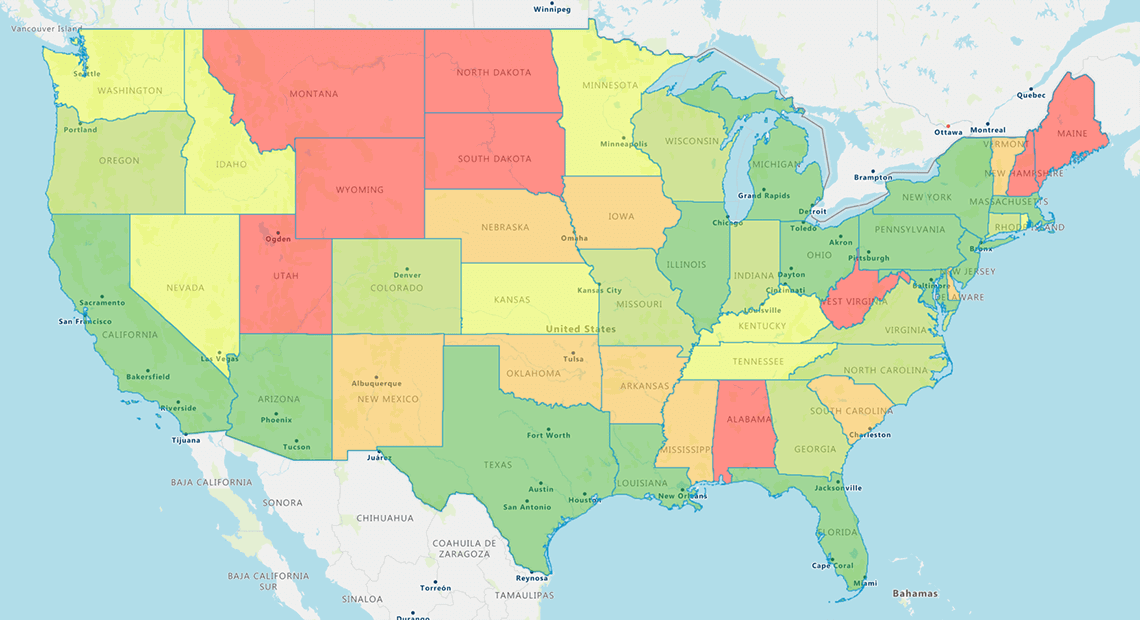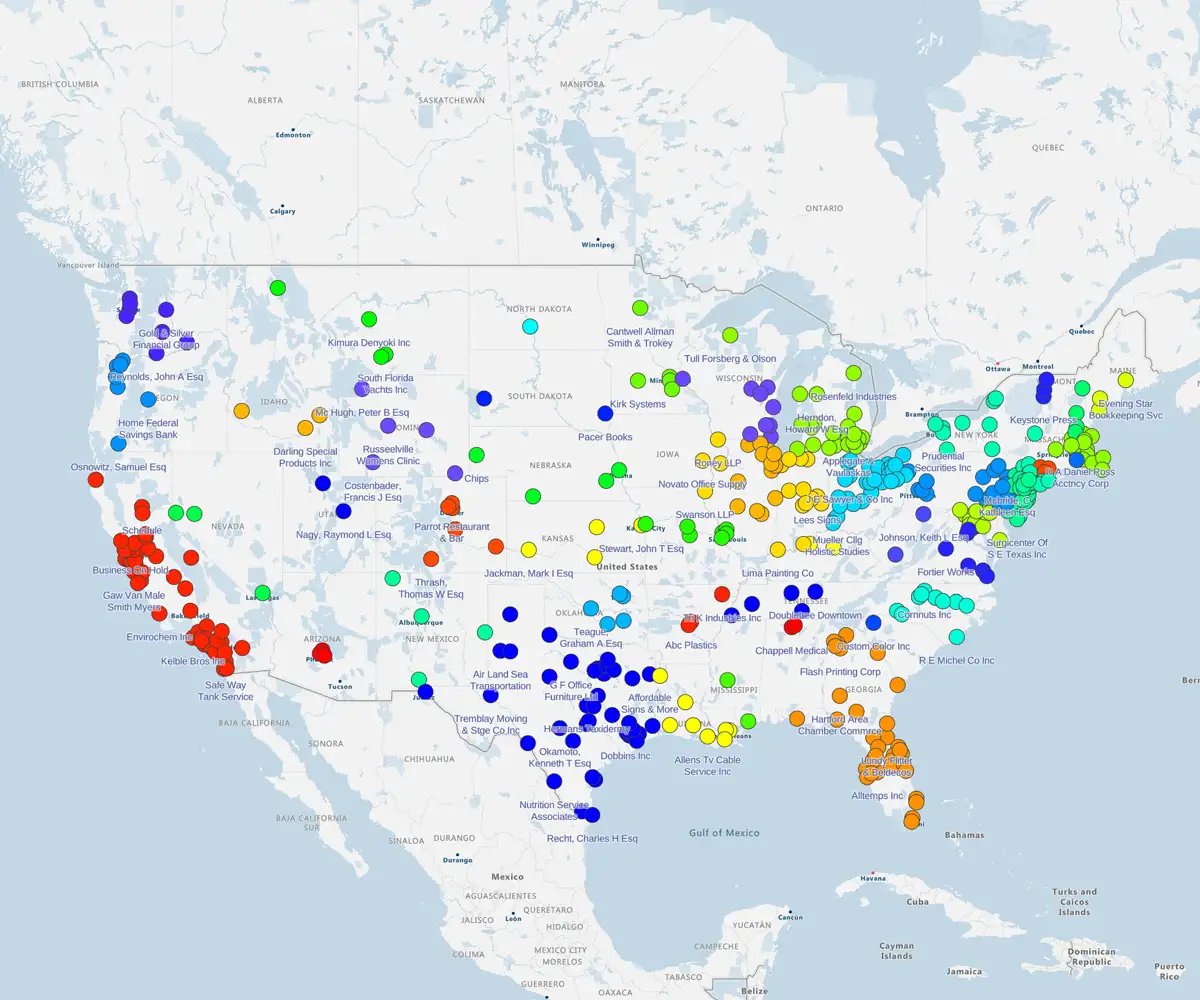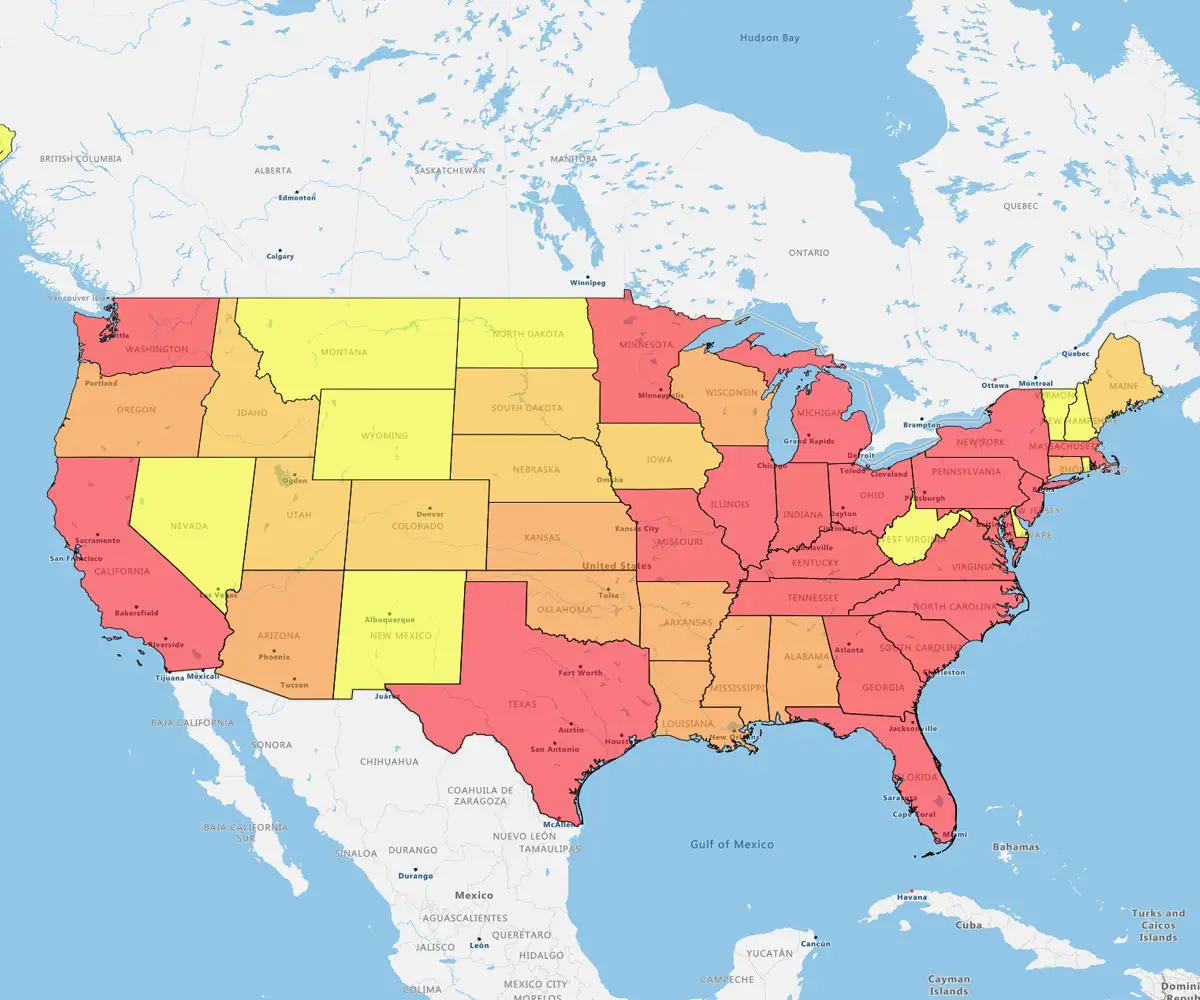Quick answer
Key Takeaways
- Analyze sales data using KPIs, segmentation, and forecasting that actually guide action
- Visualize and interpret performance with mapping tools for faster and richer insights
- Discover how to balance territories, allocate resources, and run predictive scenarios
- Use platforms like eSpatial to go from analysis to action — without the guesswork
When used well, sales data analysis reveals where your sales team is winning, where you're falling short, and what to do next. This guide breaks down how to turn complex raw data into business intelligence to help you achieve your objectives.
What is Sales Data Analysis?
Sales data analysis is the process of transforming raw sales figures, performance metrics, and geographic information into actionable insights and opportunities. In its ultimate guide to sales metrics, HubSpot suggested sales metrics could be applied to a sales rep, the sales team, or the whole company. You can track conversion rates, territory coverage, and individual rep performance using effective sales data analytics platforms.
Why Sales Data Analysis Matters
Effective sales data analysis grants sales leaders access to valuable strategic insights. The deeper understanding of performance trends and customer behavior facilitates better decision-making. To get a full picture of how mapping directly impacts performance and planning, explore these sales mapping software benefits.
How Sales Data Analysis Drives Revenue
The level of sales data analysis needed to drive good decisions and revenue requires time, effort, and data-visualization tools like a good mapping software platform. In addition to sales records, you'll need to evaluate several data types. Let's examine a few of the ways sales decision-makers can leverage their sales data analysis to drive profitability and growth:
Method 1
Establish or Realign Sales Territories

Clear territorial boundaries help reps focus on priority accounts, improve customer service, and avoid overlapping effort. Studies show that building and realigning territories based on sales data analysis reported a 2-7% increase in sales numbers.
Method 2
Sales Leaderboards Motivate Employees
Team leaderboards created from sales data analytics can foster healthy competition, reward top-performing reps, and incentivize all team members to drive improvement. Sales leaderboards can also help managers improve their sales team resource allocation, ensuring each sales rep is assigned to the most appropriate sales territories.
Method 3
Visualize Data in Meaningful Ways
Managers can't make meaningful decisions about account prioritization and resource allocation without quality sales data analysis and visual tools. Flexible mapping software is designed to help managers visualize and understand their data to generate higher sales. For instance, managers and sales teams can leverage powerful features to view:
- Sales team geographic coverage: A map of the key areas that the sales team currently covers can help managers identify new regions for expansion. eSpatial's allows users to see the geographic coverage of each sales rep individually, so decision-makers have the best understanding of their traveling sales teams' boundaries and responsibilities.
- Account and sales lead overlays: Overlay maps with the locations of current accounts and prospective sales leads to identify the highest-value accounts, as well as areas that need more attention from the sales team.
- Heat maps: Regional heat maps or hotspot heat maps reveal regional market performance, high and/or low-performing sales territories, location-based sales trends, and even clusters of existing customers.

Method 4
Improve Resource Allocation
Advanced sales data analysis reveals where you're over- or under-distributing valuable resources, a considerable advantage when allocating resources and balancing workloads. For example, mapping tools like eSpatial's Territory Manager offer balancing, showing when one sales territory has more clients than the others. When managers analyze sales coverage, they can improve workload balance and ensure every rep has a fair shot at the leaderboard with a lower risk of burnout.
Method 5
Engage in What-if Analysis
Engaging in what-if analysis involves using historical data to predict future outcomes. This is how to analyze sales data proactively to reduce risk, fine-tune your decision-making, and boost revenue. So, before adopting a new field sales strategy or establishing sales territories, you should run a few hypothetical scenarios based on real data.
Method 6
Meet SLA Requirements
When sales reps consistently meet service level agreements (SLAs), it helps build a track record of success and good customer service. Integrating sales data analysis with SLA tracking makes it easy to meet customer commitments. Consistently meeting SLAs can foster trust, increase upselling opportunities, and enhance customer lifetime value.
Method 7
Consistent Review and Improvement
Finally, all of the above elements allow managers to review their sales team's performance and associated metrics regularly. With this data, decision-makers can identify areas of improvement, adjust their sales territories, and craft new SMART objectives to help drive sales further. Conducting a thorough sales data analysis helps you determine what's working and what's not and precisely how to amplify your overall performance.
How to Analyze Sales Data:
a Step-by-step Guide
Business data mapping software can help teams across different departments integrate key metrics into a unified analysis framework. Want to learn how to turn raw data into territory-optimizing, growth-driving insights with sales data analysis? Here's a quick overview of how to proceed:
Step 1
Collecting Quality Data: The Foundation of Success
Begin your sales data analysis by ensuring your sources are reliable, up-to-date, and comprehensive. Use customer relationship management (CRM) systems, sales reports, and other tools to gather relevant information. Focus on using clean and timely data to eliminate inconsistencies and inaccuracies, laying the foundation for accurate analysis.
Step 2
Defining Key Performance Indicators (KPIs): Analyzing the Right Metrics
How to analyze sales performance begins with defining the key performance indicators (KPIs) that align with your sales and business goals. Clear KPIs, such as conversion rates, customer acquisition costs, or average deal size, provide a roadmap for analysis. These metrics become the benchmarks against which you measure the success of your sales efforts and achieve tangible improvements.
Step 3
Utilizing Advanced Mapping Software: Making Data Work for You
Invest in advanced mapping software to unlock the full potential of your sales data. Your chosen mapping platform should seamlessly integrate for sales data analytics, offering data visualization and interpretation. You can create interactive maps, conduct deep dives into specific metrics, and gain insights that drive strategic decision-making.
Step 4
Segmenting Data for Targeted Insights: Personalizing the Approach
Segmenting your data allows for more granular sales data analysis, revealing hidden patterns in complex datasets. Understand your customer segments, product categories, or geographic territories to tailor your sales strategies. Personalizing your approach based on segmented data can optimize sales and marketing efforts and improve productivity.
Step 5
Continuous Monitoring and Iteration: Adaptability is Key
Sales data analysis is not a one-time task; it's an ongoing process founded on a culture of continuous monitoring and iteration. Regularly review and update your KPIs, refine your data collection methods, and adapt your strategies based on the insights gained. An iterative approach ensures that your sales organization remains agile and responsive to market changes.
Step 6
Cross-functional Collaboration: Breaking Silos
Conquering sales data analysis requires breaking down silos within your organization – each silo possesses valid data for sales analysis purposes. Mapping software is best for cross-functional collaboration. You create a holistic approach to sales optimization that considers the entire customer journey and business operations.
Step 7
Empowering Your Sales Team With Actionable Data: Maps Built for Success
Equip your sales team with the skills and knowledge to interpret and leverage data effectively. Or take a shortcut and share a map with your critical data. Empowered with sales data analytics to make informed decisions, identify market trends, capitalize on opportunities — and do it intuitively using map visualizations.
Important Sales Metrics
Businesses Should Track
When it comes to sales data analysis, choosing what to track is half the battle. So, what sales data should you monitor? Find out below.
Method 1
Sales Revenue
Focus on trends, month-on-month or year-on-year growth. How are the numbers trending, positive or negative? This key metric anchors performance dashboards and provides context for deeper sales data analytics efforts.
Method 2
Sales Lead Metrics
Track the number of leads in your pipeline and focus on the conversion rates. You may experience a growth in the number of leads (which is good) but a decline in the conversion rates (a reason to investigate further).
Here's how to calculate the likelihood that today's leads turn into essential future sales:
- # New leads per month - 100
- # MQLs (marketing qualified leads passed to sales to work on) - 50
- # SQL's (sales have qualified leads to the next stage - 10
- # New opportunities (or deals) - 5
- # New closed sales deals - 2
My Conversions
- Lead to MQL is 50% (50/100)
- MQL to SQL is 20% (10/50)
- SQL to Deal is 50% (5/10)
- Deal to Closed Sales Deal is 40% (2/5)
Method 3
Average Time in Each Stage
This KPI measures productivity by tracking the time it takes for potential customers to become paying customers. You can combine it with metrics like lead conversion rate and total sales opportunities for a complete sales pipeline overview. To calculate it, add the total time taken for all lead conversions and divide it by the number of lead conversions during that period.
Method 4
Sales Activity Metrics
Tracking sales activities is essential, as they can be a crucial predictor of pipeline growth, but be wary of encouraging the wrong behaviors. Yes, tracking the number of emails and sales calls can be helpful, but what's most important are the outcomes of those emails and calls. Discovery calls and demos are critical results because they predict future pipeline growth.
Method 5
Sales Pipeline Value
Pipeline value is essential, but remember that it is only one metric of sales data analysis. As forecasting is notoriously inaccurate, use this one wisely. Far too often, pipeline values are inflated and overly optimistic, whereas hard facts are what matter most.
Method 6
Customer Lifetime Value (CLV)
There are a few ways to calculate customer lifetime value (CLV). However, the result provides a better understanding of how much you stand to make with a particular client throughout the relationship. With this understanding, you can then prioritize leads and opportunities.
Method 7
Monthly Recurring Revenue (MRR)
SaaS companies rely on specific metrics to track and compare their monthly revenue growth with the previous month. These metrics help companies evaluate the performance of their sales and marketing teams and identify ways to reduce customer churn to boost future revenue. For example, if 1,000 customers (monthly total) spend $50 a month (average revenue per account - ARPU), you have an MRR of $50,000.
Best Practices for Sales Data Analytics
Adopt these best practices to maximize your sales data analytics results:
- Keep your data clean, current, and centralized across systems
- Focus on a core set of KPIs that align with your business goals
- Combine geographic visualization and territory tools to deepen insights
How eSpatial Supports Sales
Data Visualization
eSpatial’s platform enriches your sales data analysis by integrating multi-source data into interactive heat maps, pin maps, and territory overlays. Built-in tools enable quick sales data analytics, making insights accessible to different interdepartmental teams and levels of hierarchy. View the pricing for eSpatial tools to explore available plans.

Boost Your Sales Strategy With eSpatial
Need a recap? To conquer sales data analysis, follow these steps:
- Collect quality data
- Define KPIs
- Utilize analytics tools
- Segment data
- Embrace predictive analytics
- Adopt an iterative approach
- Foster collaboration
- Empower your sales team
In-depth sales analysis is a critical process for today's businesses and becomes even more intuitive and valuable when teams have access to mapping software.
To learn more about how mapping software can benefit your sales data analysis, chat with one of our mapping experts or start a free trial today.


